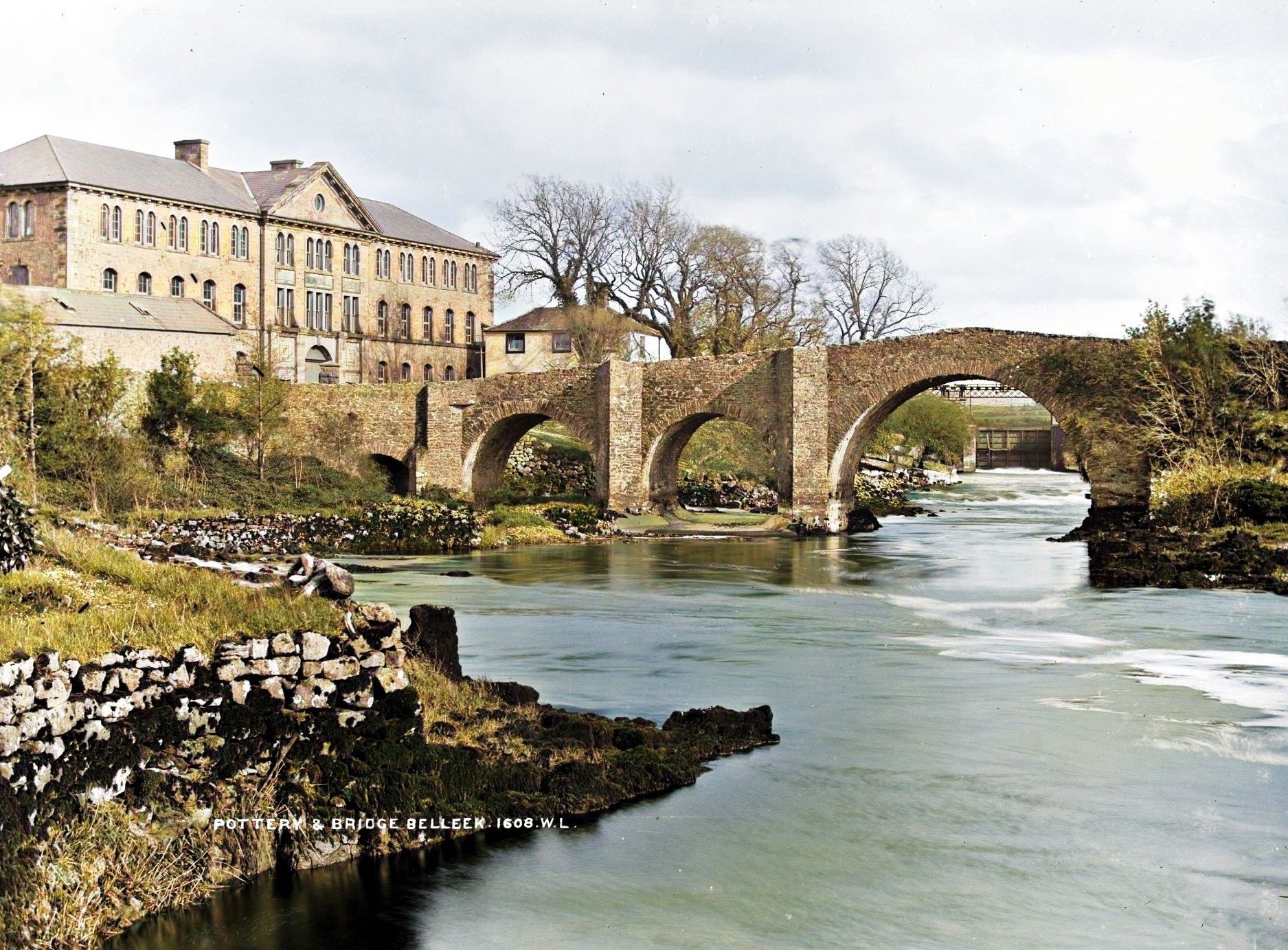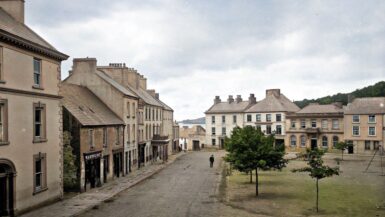Renowned globally for its distinctive designs, intricate detailing, and unblemished craftsmanship, Belleek Pottery holds an esteemed place in Ireland’s cultural heritage. Its history is not just a chronicle of ceramic artistry but an enduring narrative of the people, the place, and the unmistakable Irish spirit.
A gem nestled in the verdant landscape of County Fermanagh, Belleek Pottery is much more than a producer of fine ceramics; it is a symbol of Irish resilience, creativity, and enterprise. Founded in 1857, it predates pivotal moments in Irish history, including the struggles for Home Rule, the Irish War of Independence, and the eventual formation of the Republic of Ireland. Throughout this tumultuous journey, Belleek Pottery has been a continuous, stalwart presence. It has narrated the Irish story through its unique pottery designs, preserving a piece of the country’s history with each delicately painted shamrock and finely twisted strand of porcelain.
Belleek Pottery’s creations are housed in some of the world’s most prestigious museums, as well as adorning the homes of pottery lovers worldwide. But its significance goes beyond its commercial success. It has provided employment and fostered craftsmanship in the local community for over 150 years, contributing to the economic resilience of a region that has often felt the sharp edge of history’s challenges.
This article explores the journey of Belleek Pottery through the lens of Irish history, tracing the footsteps of its founders, celebrating its triumphs, and acknowledging the challenges it has so admirably overcome. Together, we will uncover the unique charm that makes Belleek Pottery an inextricable part of the Irish identity.
Contents

Pre-Belleek Era (Pre-1857)
Early Irish Pottery
Long before the establishment of Belleek Pottery, Ireland had a rich tradition of pottery making. The roots of Irish ceramics can be traced back to the Neolithic period, around 6000 years ago, when the first inhabitants of Ireland began to fashion clay into functional vessels. Unearthed examples from this period, like those found at Lough Gur in County Limerick, exhibit a rough, hand-built quality, showing the rudimentary beginnings of pottery in the region.
With the advent of the Bronze Age (c. 2500-500 BC) and Iron Age (c. 500 BC – 400 AD), Irish pottery became increasingly sophisticated. Decorative styles emerged, often reflecting the influence of the Celtic culture that had become prevalent in Ireland. The pottery of these periods often featured intricate geometric patterns, which became a hallmark of Celtic art.
During the Medieval period, the focus shifted back to the functional aspect of pottery, with less emphasis on decoration. However, the work was more refined than earlier examples, showing a maturing of techniques and understanding of the craft.
The arrival of the Anglo-Normans in the late 12th century brought new forms and styles of pottery. The Anglo-Normans introduced the potter’s wheel to Ireland, a significant development that led to an increase in the production speed and uniformity of pottery.
In the centuries leading up to the foundation of Belleek Pottery, there was a mix of styles and influences in Irish ceramics, reflecting the complex and often turbulent history of the nation. This vibrant backdrop set the stage for the creation of Belleek Pottery, ready to usher in a new era in the narrative of Irish ceramics.
Industrial Revolution’s Influence
The Industrial Revolution, which spanned from the late 18th century to the early 19th century, brought unprecedented changes to societies worldwide, and Ireland was no exception. This period marked a shift from agrarian economies to industrial and manufacturing ones, dramatically transforming social and economic structures.
As in other parts of the world, the Industrial Revolution in Ireland led to the rise of factories and mechanisation, greatly impacting traditional crafts, including pottery. Mass production became the norm, and many local craftspeople found it challenging to compete. However, this period also saw the standardisation of pottery production methods, leading to improved quality and consistency.
Moreover, the Industrial Revolution created a burgeoning middle class with disposable income and a desire for refined goods. Ceramics, particularly finely made and beautifully decorated pieces, were in high demand. This societal shift undoubtedly influenced the founders of Belleek Pottery, who saw the opportunity to create high-quality, artful ceramics that could cater to this new market.
Furthermore, the Industrial Revolution brought significant improvements in transportation, notably the expansion of railway networks. This advancement played a crucial role in the establishment of Belleek Pottery. The pottery’s location in Belleek, a small village in County Fermanagh, would have been prohibitively isolated were it not for the access provided by the newly built railway system. It enabled the transport of raw materials to the pottery and finished products to the market, making the operation of such an enterprise feasible.
Founding of Belleek Pottery (1857)
The Founders
The establishment of Belleek Pottery is credited to three visionary men: John Caldwell Bloomfield, Robert Williams Armstrong, and David McBirney. Their diverse backgrounds and complementary skillsets played crucial roles in the formation and early success of Belleek Pottery.
John Caldwell Bloomfield, the landlord of the Castle Caldwell estate on which Belleek Pottery was established, was the driving force behind the venture. When he inherited the estate in 1849, he commissioned a geological survey of the land. The survey revealed abundant reserves of feldspar and kaolin, essential raw materials for high-quality porcelain production. Bloomfield, determined to provide employment for the local population ravaged by the Great Famine, saw the opportunity to create a pottery.
Robert Williams Armstrong, an architect and talented ceramicist, was brought on board as the pottery’s first manager and art director. Armstrong was a key figure in developing Belleek’s distinctive style and its signature parian china, a type of bisque porcelain imitating marble. His artistic vision and technical expertise were vital to the pottery’s early successes.
David McBirney, a wealthy Dublin merchant, provided the financial backing for the venture. He shared Bloomfield’s vision of creating employment opportunities and was willing to invest in the innovative enterprise. McBirney’s role as financier was crucial in establishing and sustaining the pottery during its formative years.
Early Challenges
The early days of Belleek Pottery were not without their struggles. Several significant challenges had to be overcome to transform the vision of an innovative pottery in rural Ireland into a reality.
The logistical challenges were immense. The pottery’s remote location, while providing a beautiful setting and access to necessary raw materials, presented difficulties in terms of transportation. Despite the benefits of the expanded railway network, transporting heavy and fragile ceramics from rural Fermanagh to the wider market was a complex task. Moreover, obtaining other raw materials not locally sourced, such as coal for the kilns, required careful planning.
The technical challenges were equally daunting. Armstrong’s vision for a new type of porcelain necessitated experimentation and innovation. The process of developing Belleek’s unique parian china involved trial and error, requiring both time and financial resources. Ensuring consistent quality in the production process was a constant struggle.
Financial challenges were also a significant part of Belleek’s early history. The pottery was a considerable investment, and the return was not immediate. The company needed to establish its reputation and market its products, all while bearing the significant operating costs of a pottery.
Despite these challenges, the determination, skill, and vision of the founders ensured Belleek Pottery’s survival. They created a brand that would not only withstand these initial trials but would flourish to become a cherished part of Irish cultural heritage.
The Victorian Era (1837-1901)
Design Influences
The Victorian era, a period marked by its distinctive cultural aesthetics, greatly influenced the designs and styles of Belleek Pottery. Victorian tastes gravitated towards opulence, detail, and an eclectic mix of historical, natural, and exotic influences, all of which are evident in Belleek’s creations from this era.
The Victorian fascination with nature is one of the most recognisable elements in Belleek Pottery. Designs from this period often feature delicate shamrocks, sprigs of heather, and intricate basket weaves, reflecting the natural beauty of Ireland’s countryside. Many Belleek pieces also adopted the shape of shells and coral, reflecting the Victorian fascination with the sea and its hidden treasures.
The influence of the Gothic Revival, a defining aesthetic movement of the Victorian era, is also evident. This style, championed by architect and designer Augustus Pugin, emphasised the beauty of medieval design and craftsmanship. Belleek pieces from this period often incorporated elements of Gothic architecture, such as arches and tracery.
The Victorian era also saw a fascination with the exotic, driven by the expanding British Empire and increased global trade. This led to a trend for incorporating Asian-inspired designs in interior décor, including ceramics. Belleek responded to this trend, producing pieces such as the “International Centre Piece,” which combined traditional Irish motifs with an oriental dragon base, winning Belleek a prestigious award at the 1872 Dublin Exhibition.
Expansion and Growth
The Victorian era marked a significant period of growth and expansion for Belleek Pottery. Belleek’s unique design and superior quality soon gained it a reputation for excellence, both at home and abroad. Despite the initial challenges, the pottery managed to break into the competitive market of fine ceramics.
Belleek Pottery’s success was given a substantial boost by its victories at several international exhibitions. These included exhibitions in Dublin in 1865, Paris in 1867, and Philadelphia in 1876. At these esteemed events, Belleek’s parian china won numerous awards, beating competitors from the well-established European ceramics industries. These victories did much to enhance Belleek’s international standing, leading to increased demand for its products around the world.
This period also saw the expansion of Belleek’s product range. In addition to its iconic parian china, the pottery began to produce earthenware and stoneware to cater to a wider market. By diversifying its offerings, Belleek was able to increase its market share and ensure its financial sustainability.
In line with its growing success, Belleek also expanded its workforce. At its peak during the Victorian era, the pottery employed over 300 people, providing crucial employment opportunities in the local area. This growth mirrored the expansion of industry across Ireland during the period, positioning Belleek as a significant player in the Irish economy.
The Victorian era was truly a golden age for Belleek Pottery. Through innovative designs that resonated with the tastes of the era and successful strategic expansion, Belleek managed to secure its place on the global stage of fine ceramics, a position it still enjoys today.

The Edwardian Period and The Great War (1901-1918)
Impact on Production
The Edwardian period and the subsequent onset of World War I had profound effects on Belleek Pottery’s production and style. The Edwardian era, although brief, ushered in a shift in tastes that saw a departure from the detailed ornamentation of the Victorian era. Belleek adapted to these changes, introducing designs that reflected the simpler, more refined Edwardian aesthetic.
However, the outbreak of World War I in 1914 brought an entirely different set of challenges. The war created disruptions in trade and shortages in essential materials, impacting Belleek’s production significantly. As resources were redirected towards the war effort, Belleek, like many industries, faced a severe shortage of coal, a crucial resource for firing the pottery kilns.
Moreover, many of Belleek’s skilled workforce were drawn into the conflict, creating a shortage of labour. The war also had a profound impact on the demand side of Belleek’s operation. With the world in turmoil, the demand for fine ceramics understandably reduced.
Survival and Resilience
The challenges presented by the Edwardian period and World War I tested the resilience of Belleek Pottery. The disruption of trade, shortages of materials, and loss of workforce could have been fatal. However, the pottery demonstrated remarkable adaptability, navigating these challenging times with a tenacity that would come to define its character.
During the war years, the pottery made significant adaptations to its production. It temporarily shifted from its traditional parian china to earthenware production, which required less labour and could be fired at lower temperatures, conserving scarce coal supplies.
Belleek also sought alternative markets to maintain its viability. It expanded its reach within Ireland and the UK, focusing on consumers who were looking for high-quality domestic products to replace imports disrupted by the war.
Perhaps most importantly, Belleek’s management understood the value of its skilled workforce and went to great lengths to ensure their return after the war. The company maintained a connection with its employees who had gone to war, even sending parcels of Belleek china to the front lines as gifts to remind them of home.
Belleek’s ability to adapt and innovate in the face of adversity ensured its survival through one of the most tumultuous periods in history. Its resilience during these years is a testament to the enduring spirit that has carried Belleek Pottery through over 150 years of operation.
Interwar and World War II Period (1919-1945)
Economic Challenges and Changes
The interwar period presented a new set of economic challenges for Belleek Pottery. The aftermath of World War I saw a global recession, with countries around the world grappling with the economic devastation wrought by the war. Ireland was no exception, and Belleek, like many businesses, faced significant financial strain during this period.
Compounding these economic challenges was the political upheaval in Ireland, culminating in the partition of Ireland in 1921. This development resulted in trade barriers between Northern Ireland, where Belleek is situated, and the newly formed Irish Free State. These restrictions disrupted Belleek’s domestic market, further hampering the pottery’s recovery from the economic challenges of the war years.
The onset of World War II in 1939 again led to disruptions in trade and shortages in essential resources. However, the lessons learned from the previous war, along with the company’s inherent resilience, helped Belleek to navigate these challenges more effectively.
Product Evolution
Despite the significant economic and political challenges of this period, Belleek continued to innovate and evolve its product line. The interwar years saw a shift in consumer tastes towards Art Deco design, characterised by streamlined forms and geometric motifs. Belleek responded to this trend by incorporating Art Deco elements into its designs, maintaining its reputation for style and refinement.
Belleek also continued to evolve its production techniques during this period. The pottery began experimenting with glazes and firing techniques, resulting in unique finishes and colours that added to the distinctiveness of Belleek products.
The World War II years saw a return to simpler, more utilitarian designs. This change was both a response to the austerity of the times and a practical consideration, as labour and materials were once again in short supply. Belleek’s adaptability in design and production ensured its relevance and survival through another period of global upheaval.
The interwar and World War II period, while fraught with challenges, also demonstrated Belleek’s enduring resilience and its ability to adapt and innovate. Through economic adversity and shifting trends, Belleek Pottery persisted, cementing its reputation as a beacon of Irish craftsmanship.
Post-War Recovery and Modern Era (1946-Present)
Belleek in the Modern World
The post-war years marked a new chapter in Belleek Pottery’s history. As the world recovered from the devastation of World War II, so too did Belleek, adapting once again to the changing economic, social, and aesthetic landscape.
In the immediate post-war period, Belleek faced the task of rebuilding its workforce and restoring its production capacity. While the company continued with the more utilitarian designs necessitated by the war, the economic recovery of the 1950s and 60s allowed Belleek to return to producing its more ornate and artistic pieces.
Belleek also made important adaptations to its production techniques during this period. The post-war years saw advancements in ceramic technology that Belleek incorporated into its production process, improving efficiency and product quality. At the same time, the company maintained its commitment to traditional craftsmanship, striking a balance between modernity and heritage.
The changing aesthetic trends of the modern era were reflected in Belleek’s designs. The mid-century saw a preference for minimalism and functionality, followed by a revival of interest in traditional and handmade items towards the end of the 20th century. Belleek responded to these changes with characteristic adaptability, producing designs that catered to contemporary tastes while maintaining its distinctive Irish character.
Belleek’s business strategy also evolved during this period. Recognising the importance of tourism, the company opened its doors to the public in the 1980s, offering tours of its historic pottery. This move not only created an additional revenue stream but also allowed Belleek to showcase its rich history and craftsmanship, further enhancing its brand.
Belleek Today
Today, Belleek Pottery stands as a testament to over 160 years of Irish craftsmanship and resilience. As one of the oldest working potteries in the world, Belleek continues to produce its distinctive Parian china, maintaining its reputation for excellence in the world of ceramics.
Modern Belleek products continue to reflect the company’s Irish heritage, with designs featuring traditional motifs like the shamrock and the Celtic knot. However, Belleek also produces contemporary designs, reflecting the company’s continued adaptability and relevance in the modern market.
Despite the significant changes in the ceramics industry and the broader world, Belleek remains committed to its traditional handcrafting techniques. Each piece of Belleek china passes through 16 pairs of hands from moulding to final glaze, ensuring the highest quality and attention to detail.
Belleek’s current operations also reflect its commitment to sustainability, a key concern in the modern era. The company has implemented measures to reduce its environmental impact, including waste reduction and energy efficiency initiatives.
As Belleek Pottery looks towards the future, it does so with a deep respect for its past. The company preserves its historical legacy, not just through its products, but also by maintaining its historic buildings and offering pottery tours that delve into Belleek’s rich history.






Leave a reply